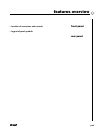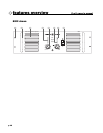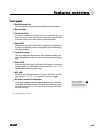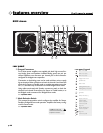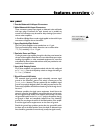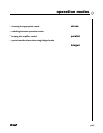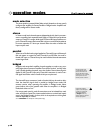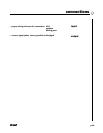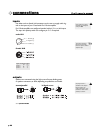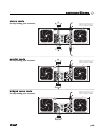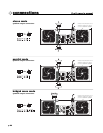
Pro II owner’s manual
p.18
operation modes
4
mode selection
The three-position,recessed Mode Select switch (located on the rear panel)
configures the amplifier for Stereo, Parallel or Bridged mode. Amplifiers are
factory-configured for Stereo mode.
stereo
In Stereo mode,both channels operate independently,with their input atten-
uators controlling their respective levels.Signal at Channel A’s input produces
output at Channel A’s output,while signal at Channel B’s input produces out-
put at Channel B’s output.Recommended minimum nominal load impedance
for stereo operation is 2 ohms per channel. Either the male or female
XLR
inputs may be used.
parallel
When set to Parallel mode,a signal applied to Channel A’s input will be ampli-
fied and appear at outputs for both Channels A and B. Either the male or
female
XLR input on Channel A may be used. Individual channel attenuators
control signal level.
bridged
Bridged mode straps both amplifier channels together to make a very pow-
erful, single-channel monaural amplifier.One channel “pushes” and the other
“pulls” equally, doubling the power over that of either channel alone. Signal is
applied to the Channel A input only. Channel A’s attenuator is used to con-
trol signal level. Either male or female
XLR input may be used.
The channel B input connectors (male or female
XLR) may be used to daisy-
chain the channel A signal when in parallel or bridged mono mode. Use
extreme caution when operating the amplifier in Bridged mode. Never
ground either side of the speaker cable when the amplifier is in Bridged
mode; both sides are “hot.”
If an output patch panel is used, all connections must be isolated from each
other and from the panel.The recommended minimum nominal load imped-
ance in the Bridged mode is 4 ohms, which is the equivalent to driving both
channels separately at 2 ohms.
see—connections for examples of mode-specific wirings
Driving bridged loads
of less than the recom-
mended minimums will
activate the IGM circuitry,
resulting in a loss of power,
and may also lead to a
thermal protect condition.
a
Connecting amplifier
outputs to oscilloscopes
or other test equipment
while the amplifier is
in bridged mode may
damage both the amplifier
and test equipment!
a




